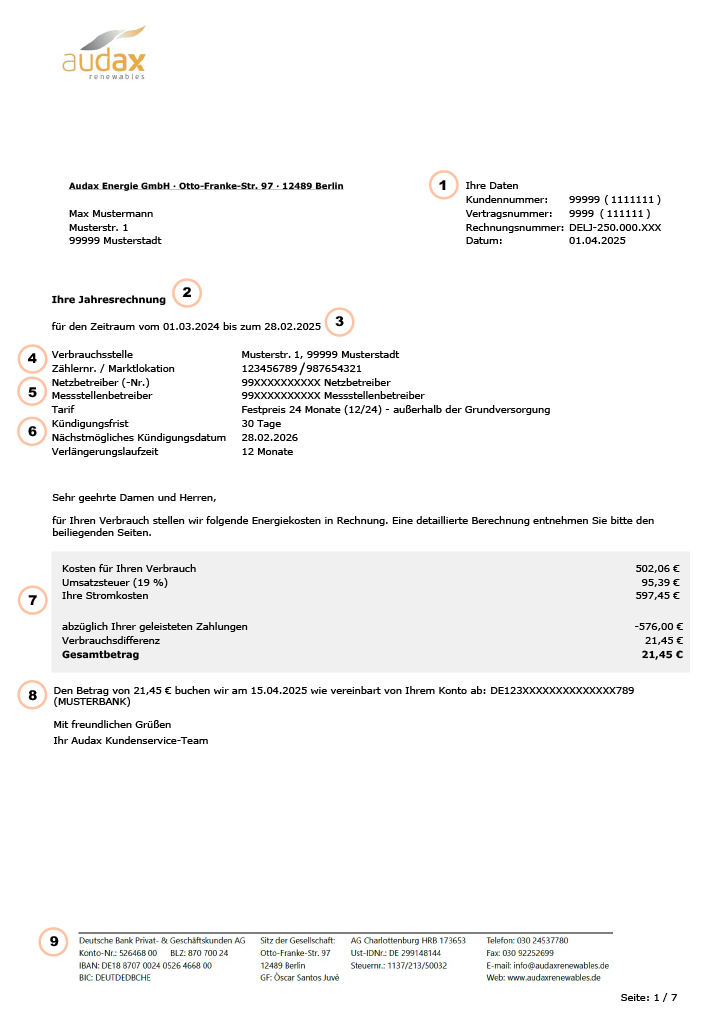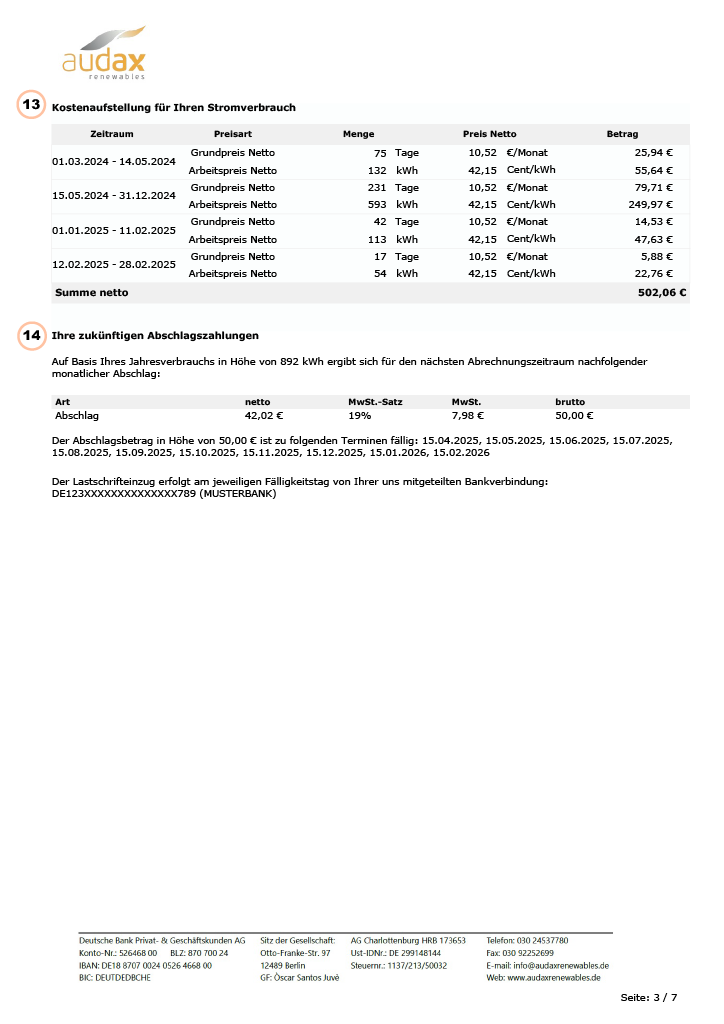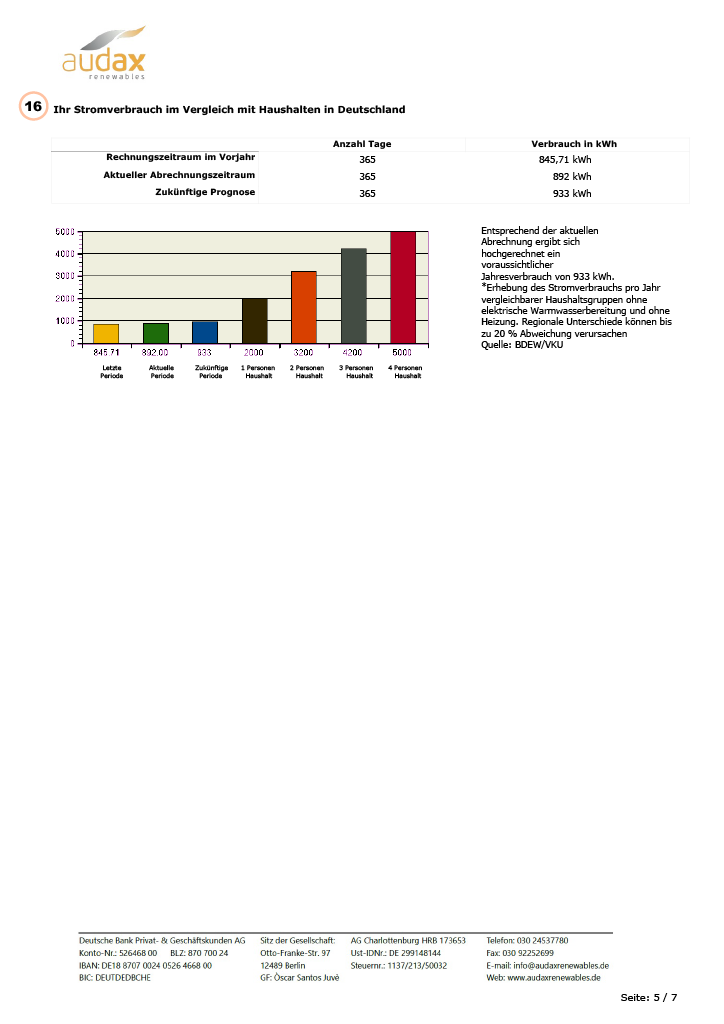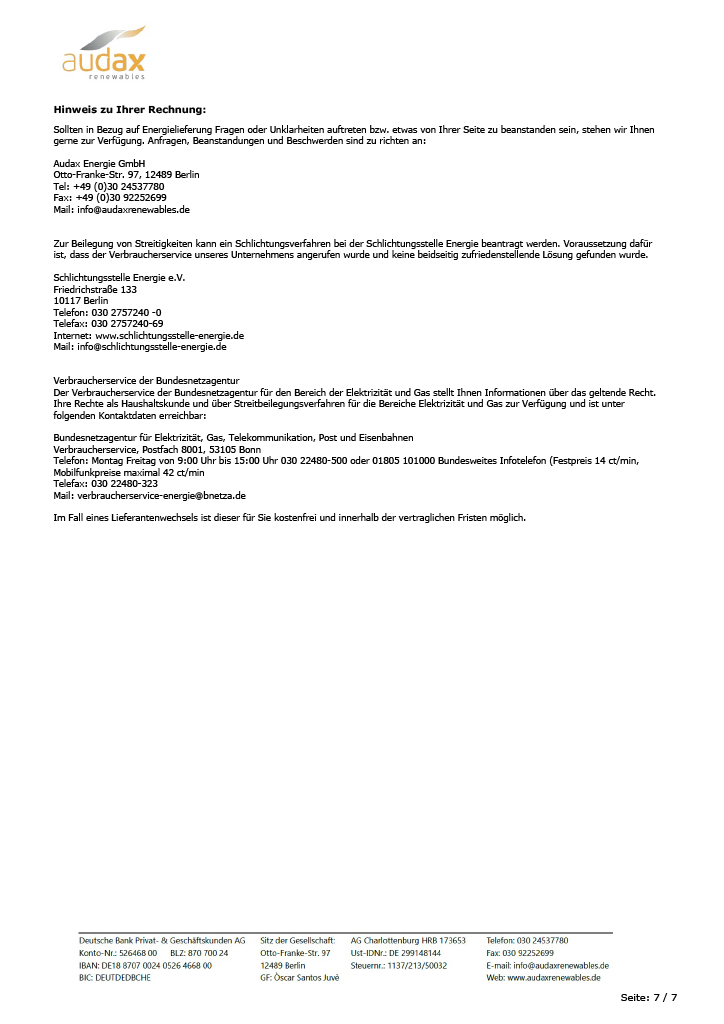Understanding the electricity bill
We strive to make our electricity and gas bills as clear and understandable as possible. However, we recognize that some technical terms and specific information are not always immediately clear.
To help you navigate, we've created a sample calculation. Using this sample calculation, we'll explain the most important items, terms, and calculations step by step. This will help you better understand your own calculations and ensure you always understand exactly how the amounts are calculated.
Invoice explanation







When making bank transfers, please always include your customer number and invoice number as a reference so that your payment can be correctly recorded. It is also important to provide your customer number and contract number in correspondence or for inquiries so that we can process your request quickly and clearly.
Here you can see what type of bill you're dealing with. You'll typically receive an annual bill for your total energy consumption once a year. When your contract ends, for example, due to a move or termination, we'll issue you a final bill. You can also request an interim bill if you require a bill by a specific date.
Here you can see the connection for which the bill was generated. The meter number and market location are important for clearly recording your consumption and allocating it to you individually.
This indicates which company is responsible for network usage and which is responsible for reading and maintaining your meter. This information is required by law.
Your current plan and its terms and conditions are listed here. This way, you know how long your contract lasts and when you can cancel.
This section of the bill shows an overview of your energy consumption costs, including VAT. Below that, the advance payments you've already made are taken into account. This ultimately results in the total amount. If your payments exceed the actual costs, a credit will be created that will be refunded to you. If your payments are less than the costs incurred, you'll have an additional payment, which must be paid by the due date shown.
Here you will find the due date and the bank account details used to collect the due amounts by direct debit. If the statement shows a credit balance, we will automatically transfer the amount to this account within two weeks.
If we do not have your account details, please inform us in writing so that we can process a payment if you have a credit balance.
If we don't have a direct debit mandate, please transfer the outstanding amount by the due date. You can find the bank details in the footer of the invoice.
At the bottom of the invoice, you'll find our full contact details, including address, telephone number, and email address. Our bank details and other important information are also listed there.
This overview shows you exactly which components are included in your total bill. These include statutory charges such as concession fees and electricity taxes, as well as grid fees and surcharges for grid operation. These costs are prescribed by law and are collected and passed on in the same way by all energy suppliers.
Also included are the costs for energy purchasing and distribution, i.e., the actual electricity price and services. This gives you a transparent overview of the pricing structure.
Here, your consumption is displayed based on the meter readings. The time periods, the respective starting and ending readings, and the resulting kilowatt hours (kWh) are listed. This allows you to see step by step how your annual consumption breaks down and in which months you used the most or least electricity.
Some meters also use a conversion factor—for example, in larger systems. This is multiplied by the metered consumption so that the actual amount of electricity can be calculated correctly. If your meter doesn't require such a factor, the value 1 will appear on your bill, meaning no conversion takes place.
The key explains how the individual meter readings were calculated: by your own reading, by the metering point or grid operator, or by calculation. This helps you immediately see whether the readings are actual or estimated. For estimates, we recommend checking the meter reading yourself and informing us of any discrepancies.
This table shows you the breakdown of your electricity costs in detail. It shows the time periods, the amount consumed in kilowatt hours (kWh), and the respective prices per unit. This shows you exactly what costs were incurred for the base rate (a fixed amount, regardless of consumption) and the energy rate (per kWh consumed). The net total of all items is displayed at the bottom of the table. VAT is then calculated before the final amount is calculated.
A new monthly payment will be calculated based on your annual consumption and the current electricity rate. This fixed amount is due each month on a specified date. This way, your energy costs are spread evenly throughout the year, rather than having to be paid all at once.
100% of our energy comes from renewable sources. This actively contributes to climate protection and avoids additional CO2 emissions. The electricity labeling provides a transparent overview of our energy mix and how it compares to the average electricity mix in Germany.
In this diagram you can see how much your own annual consumption is compared to average households in Germany.
The last two pages of your invoice contain general and legally required information. We've also included brief explanations of important technical terms. This ensures that your invoice remains transparent and understandable for you at all times.
Explanations of terms
To make it easier for you to understand, we have summarized the most important technical terms from your invoice here and briefly explained them:
Point of consumption / point of consumption - Place where the energy supply is provided.
Advance payments - The advance payments are a partial payment or down payment on the energy already delivered and are offset against the regular final bill. The amount of the advance payment is based on the expected energy consumption.
Labor price - Refers to the price for one kilowatt hour of energy used.
EEG surcharge - The EEG surcharge was a financial levy on electricity prices in Germany that was abolished on January 1, 2023. The EEG (Renewable Energy Sources Act) surcharge promoted the generation of electricity from renewable energies.
Base price - Expenses that arise independently of energy consumption.
Concession fee - Fees paid to the municipality for the shared use of public transport routes by utility lines.
CHP levy - The levy promotes the resource-efficient simultaneous generation of electricity and heat. The costs resulting from the Combined Heat and Power Act (KWKG) are passed on to final consumers nationwide.
Metering point operation - Includes the provision, operation and maintenance of meters.
measurement - Includes the determination of energy consumption as well as the collection, management and provision of meter data.
Network operator number - Serves to uniquely identify the local distribution network operator to whose network the delivery point is connected.
Network usage charges - Fees charged by the energy network operator for the transport and distribution of energy.
Offshore grid levy - The offshore grid levy has been a component of the Electricity price for end consumers. It is shown as a separate amount on the electricity bill. The surcharge was introduced due to potential compensation payments to offshore wind farm operators for delayed connections to the onshore transmission grid or prolonged interruptions in the connection. Since January 1, 2019, the surcharge also includes the costs for the construction and operation of the connecting lines, which have since been no longer included in the grid charges.
Electricity labeling - Provides information about the origin of the electricity used (energy mix) and its environmental impact. This is required by law.
Electricity tax - A tax on energy consumption regulated by the Electricity Tax Act.
Levy according to Section 19 StromNEV - - The surcharge finances the relief or exemption of electricity-intensive companies from grid charges. The charges resulting from the Electricity Grid Charges Ordinance (StromNEV) are passed on to end consumers nationwide.
consumption - The energy consumption for the respective billing period is shown in kilowatt hours (kWh).
converter - Measuring transformers reduce high currents or voltages. The corresponding measured value (e.g., consumption, power) must be multiplied by the transformer factor.





